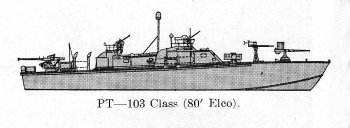![]() The Pacific War Online Encyclopedia
The Pacific War Online Encyclopedia
|
| Previous: El Segundo | Table of Contents | Next: Elizabeth C. Stanton Class, U.S. Transports |
 ONI 222 |
| Tonnage | 39 tons standard |
| Dimensions | 80' by 23' by 5' 24.4m by 7.0m by 1.5m |
| Maximum speed | 41 knots |
| Complement | 17 |
| Armament | 4 21" torpedo
tubes 1 20mm Oerlikon AA gun 2 machine guns |
| Machinery |
3-shaft internal combustion
engine (4500 shp) |
| Bunkerage |
3000 gallons aviation gasoline |
| Range |
358 miles (576 km) at 35 knots 1050 miles (1690 km) 11 knots |
| Modifications |
A large number were fitted with additional
machine guns and cannon, often after landing their torpedo tubes. The
heaviest effective armament was a single 40mm Bofors AA gun. A typical balanced configuration by 1943 was 2x2 0.50 machine guns, 1 40mm gun, 1 37mm gun, and 4 21" torpedoes. A modest amount of armor protection was applied to some
boats. |
The Elco PT boats were constructed
from 1940 to the end of
the war in several variants. They were generally faster and
better at sea keeping
than the Higgins
PT boats and were built in
greater numbers.
The design dated back to July 1938, when the Navy announced a design contest for a motor torpedo boat. None of the designs proved satisfactory, but a minor scandal erupted when the Navy proceeded to purchase an entire squadron of British motor torpedo boats and to give Elco the funding for a motor torpedo boat factory. The decision likely reflected the rush to prepare for war, rather than any corrupt dealings between the government and Elco, and in the end the Elco design was only loosely based on the British boats.
The boats were built plywood and mahogany and were propelled by powerful gasoline engines.
The exhaust was passed through mufflers that could be set to eject the
exhaust underwater, further reducing their noise signature.
PT boats in the Solomons proved ineffective in their original role as torpedo boats, but those deployed to New Guinea proved effective at breaking up Japanese barge traffic. As a consequence, the PT boat was reinvented as a small, fast gunboat. It was found that the armored Japanese barges that began appearing in the Solomons in July 1943 were immune to anything less than 40mm cannon fire, and a large number of PT boats landed some or all of their the torpedo tubes to compensate for the heavy 40mm cannon.
The original torpedo armament of the PT boats was the Mark 8 torpedo, a miserable weapon left over from the First World War. This was replaced with the much better Mark 13 torpedo early in 1944. Whereas the Mark 8 had to be launched from a torpedo tube, the Mark 13 could be launched simply by rolling it overboard, allowing the PT boats to land their heavy torpedo tubes without sacrificing torpedo armament. At the same time, some boats were armed with such exotic weaponry as 4.5" rocket launchers and mortars. An attempt to arm one PT boat with a 75mm gun proved unsuccessful due to its low rate of fire. |  |
 |
 |
 |
References
NAVSHIPS 250-222-1 (1945-7-15; accessed 2014-3-25)
The Pacific War Online Encyclopedia © 2007, 2009, 2011-2012, 2014 by Kent G. Budge. Index